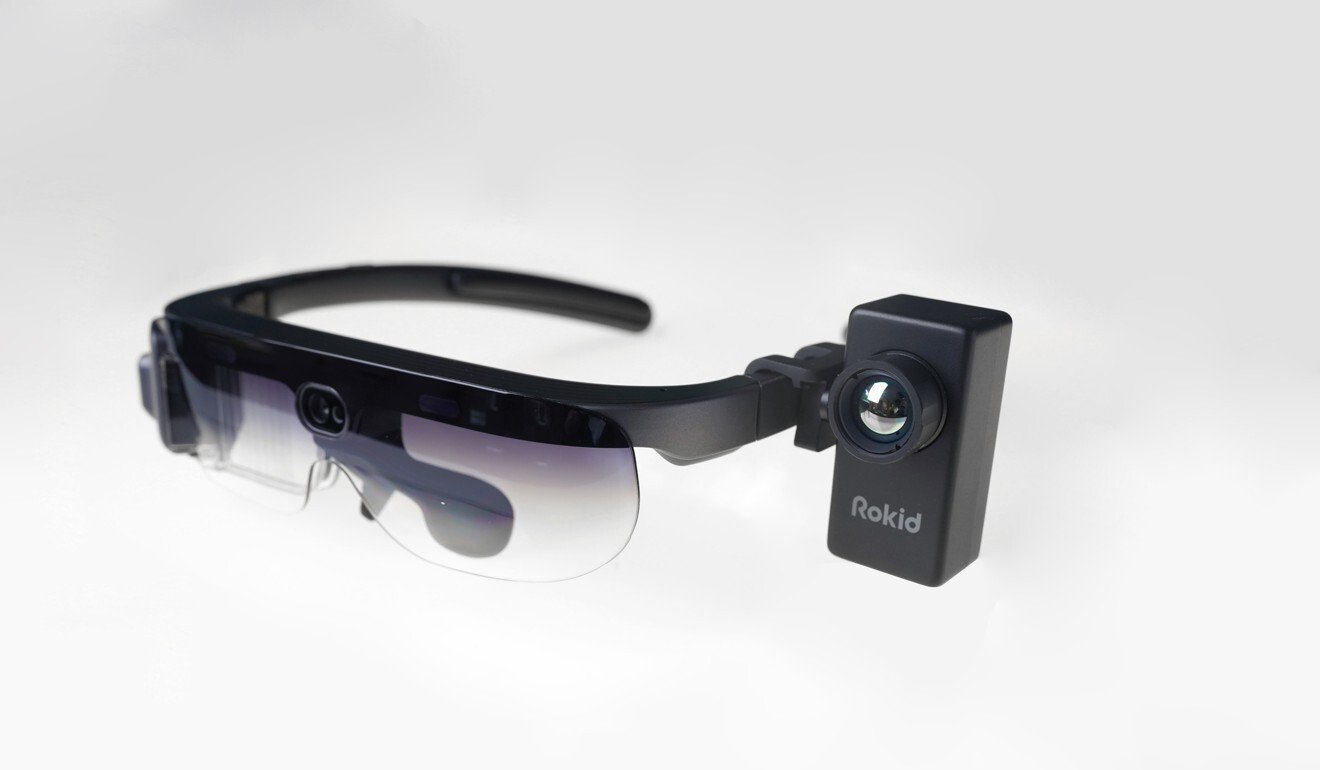
Chinese AR start-up Rokid eyes industrial applications after success with temperature-reading smart glasses
- Shipments of Rokid Glass 1 soared between April and June, giving the company one of its biggest commercial successes since its foundation in 2014
- In China, the AR and VR market is forecast to grow 66 per cent year on year to US$4.09 billion in 2020, according to IDC
Imagine being able to blur the lines between reality and the virtual world by putting on a set of augmented reality wearables, just like Major Motoko Kusanagi in the Japanese anime classic Ghost in the Shell.
Rokid, a Hangzhou-based augmented reality (AR) and artificial intelligence (AI) start-up, is among a number of Chinese companies trying to bring this vision into reality.
The company expects its new smart glasses product to expand end-use applications into industries such as art expositions, entertainment, and manufacturing after its body temperature-detecting smart glasses were used in more than 30 countries to help limit the spread of Covid-19.
“It was an important period for our brand-building,” said Rokid founder Zhu Mingming, who previously headed an AI research lab at Alibaba Group, owner of the Post.
As the threat of the pandemic appears to have abated in China, the 6-year-old company – which counts Temasek Holdings and Credit Suisse Group as investors – has been gearing up for mass shipments of its next generation of AR smart glasses, the Rokid Glass 2.
Rokid promises to mass produce AR glasses
“I think we are nearing a tipping point where the sales of smart glasses with diversified features will outgrow those with [just] temperature control in the second half,” Zhu said, adding that the company has received enquiries from Germany and Russia about models with diverse features.
Rokid Glass 1, initially used in Hangzhou’s Xixi National Wetland Park, enabled security staff to conduct bulk body temperature measurements of visitors within a 1 metre distance.
Despite gaining fame during the pandemic, the company’s smart glasses were initially designed for industrial applications, such as detecting overheating in machinery.
“We took about two to three weeks to quickly integrate AI-powered human-recognition technology with the industry-facing application and arranged for it to be released on the market quickly,” Zhu said.
Subsequent shipments of Rokid Glass 1 soared between April and June, giving the company one of its biggest commercial successes since its foundation in 2014, enabling it to rapidly roll out the updated version.
Rokid Glass 2 was lighter at only 90g and was designed with a more futuristic appearance compared to the first version that resembled classic sunglasses. With the inclusion of an infrared sensor and larger batteries, version 2 can measure the temperatures of 10 people simultaneously within a range of 3 metres.
The latest smart glasses, which can be controlled by voice and head movements, also support group live streaming for real-time consultations between on-site workers and back room experts in the manufacturing and mining industries.
Zhu said the company is focused on the professional market rather than consumers because industry and business customers have a higher price tolerance than individuals. The bulk order price for one pair of the second generation glasses ranges from US$3,000 to US$5,000, while Rokid Glass 1 on Amazon is priced at a hefty US$6,800.
In China, the AR and VR market is forecast to grow 66 per cent year on year to US$4.09 billion in 2020, higher than the average global growth rate, according to a July forecast by analytics firm International Data Corporation (IDC).
“Spending [on AR and VR] in commercial areas will keep growing due to the massive roll-out of 5G networks, lower technology costs, and growing benefits in the application of the technologies,” IDC analyst Yao Yumo said in a recent research note. “Companies will land more projects and are going to generate commercial benefits.”

Rokid’s competition could intensify because deep-pocketed tech giants like Microsoft and Google have also been focusing resources on improving their existing AR and VR offerings to address the business market.
Local rivals like Nreal, founded in 2017 by a former Magic Leap employee, are instead focused on the consumer market.
Smartphone makers such as Huawei Technologies and Vivo are also eyeing the smart wearables market, including AR glasses, with products that can offer features such as mobile office, AR-based games, 3D high-definition video, and object and people recognition.
Microsoft’s HoloLens 2 mixed reality (MR) headset, a lighter, upgraded version of the model first released in 2016, is currently priced at US$3,500. With a wider field of view, real-time 3D experience and hands-tracking function, it has already had success in industries such as manufacturing, design, and health care.
“At the current stage, MR is more for professional and business users,” said Li Yingtong, director of innovation at Microsoft Research Asia, adding that for the technology to appeal to a broad segment of consumers it needs to be more mature and offer an abundance of apps.
Large-scale adoption of AR technology has been blunted by poor user experience and technical glitches, according to tech industry representatives. In a survey of 200 start-up founders and executives last year, more than 26 per cent said bulky hardware or technical glitches were the main contributors to the poor user experience, and thus the biggest obstacle to mass adoption of AR.
The survey, conducted by law firm Perkins Coie and the XR Association, also found that a quarter of the respondents cited lack of quality content as the biggest obstacle for AR adoption.
Microsoft’s Li said this was the “inevitable direction of the future,” adding that a killer consumer app could be found in the era of 5G.

